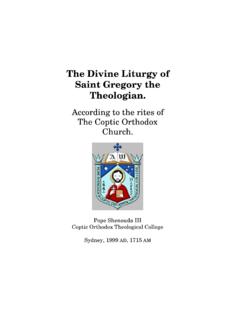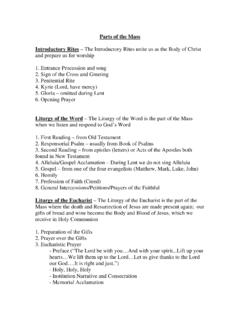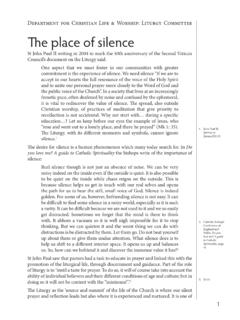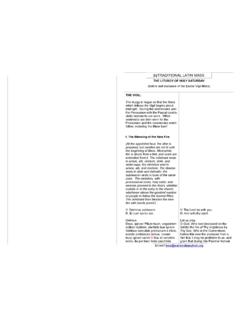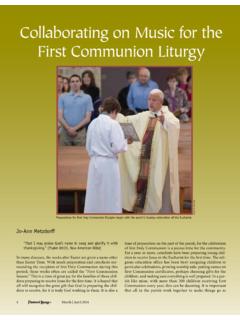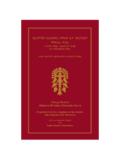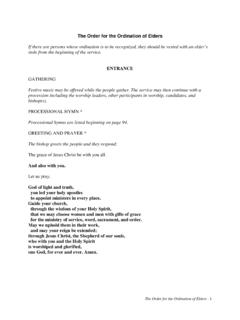Transcription of The Coptic Liturgy Of St. Basil - CopticChurch.net
1 ST. Basil Liturgy Reference Book THE FULL TEXT STEP BY STEP EXEPLANATIONS COMMENTARIES Preparatory Edition Edited By Fr. Abraam D. Sleman 2 CONTENTS PART I. THE OFFERTORY 1. The Preparation: Getting Dressed Preparing the Altar The Canonical Hours The Hand Washing The Orthodox Creed 2. Choosing the Lamb: The Rite of Choosing the Lamb The Procession of the Lamb The Lamb's Blessings 3. The Thanksgiving: The Opening Greeting The prayer of Thanksgiving 4. The Prayer of Offertory: PART II. THE Liturgy OF THE CATECHUMENS 1. The Absolutions: The Absolution to the Son The Absolution of the Ministers 2. The Readings: The Pauline Epistle The Catholic Epistle The Act of the Apostles The Sinaxarium The Psalm and the Gospel The Sermon 3. The Prayer of the Veil: Liturgy of St. Basil Reference Book 34. The Long Litanies: The Litany of Peace The Litany of the Fathers The Litany of Congregation 5.
2 The Orthodox Creed: 6. The Pre- Anaphora: Washing the Hands The Prayer of Reconciliation The Apostolic Kiss PART III. THE Liturgy OF THE FAITHFUL 1. The Anaphora (Eucharistic Prayers): The Lord Is With you Worthy and Just The Sanctus (Holy. Holy. Holy) 2. The Consecration: The Institution Narrative The Anamnesis The Epiclesis - The Invocation of the Holy spirit 3. The Litanies: The Litany Peace the Fathers of the Church The Litany of the Fathers The Litany of Mercy The Litany of the Place The Litany of Waters, Etc. The Litany of the Oblations 4. The Commemoration of the Saints: 5. The Diptych: 6. The Fraction: 4 Prayers before the Fraction Prayer of the Fraction The Lord's Prayer Inaudible Prayers 7. The Confession: Prayers before Confession The Prayer of Confession 8. The Communion: Communion Praises Prayer after Communion 9. The Dismissal: The Prayer of Laying the Hands The Ending Blessing PART VI.
3 FRACTION PRAYERS FOR DIFFERENT OCCASIONS: 1. Nativity and Christmas Eve 2. Theophany 3. The Great Lent 4. Palm Sunday 5. The Holy Thursday 6. The Great Saturday 7. Easter through Pentecost 8. The Lords Feasts 9. The Apostles 10. The Holy Virgin and the Angels 11. The Son from St. Cyril's Liturgy 12. The Son 13. The Son from the Gregorian Liturgy Liturgy of St. Basil Reference Book 5 PREFACE The Coptic Church of Alexandria has kept the apostolic and patristic spirit of the liturgies allover the centuries. The richness of the Coptic Liturgy is obvious and easy to be experienced by attending the service and studying the Coptic Liturgy has its special importance. Our main Concern in this book is the Liturgy of the Eucharist, which is commonly known as The Liturgy of St. Basil . This book is written primarily for those people who do not speak Arabic and/or Coptic .
4 It is also written for people who are learning about the Coptic Orthodox faith and the Coptic Liturgy or Mass. Commentaries, Step by step explanations of what is going on during the mass and the meanings of various sections are provided. At the end of the book you will find also some words that are uncommon. Their meanings are provided for your understanding. The entire book has been formatted in a way that it can be used and followed easily during the mass and for the personal studying. We hope that this book will be helpful for you to enjoy the spirit of the Coptic Liturgy , as we do. May God bless you as will as the mission of this book, by the blessings of our Holy Mother St. Mary, St. Mark, St. Cyril and of all the innumerable choir of the saints.
5 May He also accept the prayers for Pope Shenouda III on our behalf and ours for him that He grant him many years of peaceful times. 6 PART I THE OFFERTORY Since the early church times, the faithful have used to come to the church bearing their offerings. The bread and wine are included in these offerings, in addition to other oblations like oil, cheese, olives, etc Offering bread and wine is not only a physical necessity for the Eucharist, but it has a spiritual meaning. As The Lord Jesus offered himself a sacrifice of love to God the Father on our behalf, we ought to offer our selves totally, through our unity with him, as His own body. By the Offertory, the Church declares in a practical way her acceptance to the sacrifice of the Lord Jesus, as well as her willingness to offer her life as a sacrifice of love for Him.
6 Our life together with our labor, joys, sorrows, hopes, ambitions. Hardships, represented , by offering the bread and wine. The essence of our sacrifices is not our money or possessions, but offering ourselves and our lives in Jesus Christ. The Priest says, in the fraction prayer of the Easter; "He, Christ, raised His saints on high with Him; and offered them as an oblation to His Father". For this reason, the Church does not accept the oblations of the unjust, the adulteress, the avaricious and the unbelievers, if they still not repenting. 1. The Preparation As we start the journey of the Liturgy and the Eucharist, The Church realizes that this is a unique journey. It is a departure from the earthly concerns to that of the heaven. How dreadful are these moments, for the Church is moved toward the throne of God, in front of Him, in accompany with the Cherubim, the Seraphim and all the choirs of the heavenly hosts, offering to the Father the sacrifice of His Only Begotten Son by His Holy spirit .
7 So, we have to be prepared well for this service. Liturgy of St. Basil Reference Book 7 The Rites of the Preparation: To receive the law, Moses was ordered that all the people should be sanctified for three days. The church commands the priests and the people to be prepared for receiving Communion. Repentance, confession, contrite hearts praising God is the heart of the preparation. Getting Dressed Before starting the service, the priest and deacons put off their clothes, which they use in their daily life. They wear other clothes sanctified by the prayer of the bishop and dedicated for the service of the Lord. In the Old Testament, the high Priest's special dress represented his function as mediator between God and man1. Over the trousers, coat, girdle, and cap, worn by all priests, the high priests wore an EPHOD, a two piece apron reaching to his hips, made of royal colors (blue, purple, and scarlet), and sewed with gold thread.
8 By two onyx stones bearing the names of the twelve tribes of Israel fastened to the shoulders of the ephod, he brought the whole nation before God in all his Priestly acts (Ex. 28:5-14). The "breastplate of judgment," made of the same material was attached to the front of the ephod (Ex. 28:15-30). On its front were 12 precious stones engraved with the names of the 12 tribes. In its pocket, directly over his heart, were the URIM AND THUMMIM (Ex. 28:30), the medium through which God could communicate His will. By this the high priests was Israel's advocate before God and God's spokesman to them. Over the breastplate he wore the blue "robe of the ephod" (Ex. 28:31). Around its hem were pomegranates, pointing to the divine law as sweet and delicious spiritual food (Deut. 8:3), and bells that would ring as he went "into the holy place before the 1 Nelson's Illustrated Bible Dictionary- Copyright (C) 1986, Thomas Nelson Publisher 8that he may not die" (Ex.)
9 28:35). The bells announced God's gracious salvation for He had accepted the people in the person of their advocate, the high priests. On his forehead the high priests wore "the holy crown" of gold engraved with the words, "Holiness to the Lord" (Ex. 28:36-37). Thus he was represented as bearing "the iniquity of the holy things" (Ex. 28:38) which Israel offered to God and crowned mediator, making atonement for the nation so God might accept their gifts and show them favor. All these garments stood for the "glory and beauty" (Ex. 28:40) which God placed upon his priests , sanctifying them to minister in His name (Ex. 28:3). The clothes, which the priests wore also, carried great significance2. Their white linen garments symbolized holiness and glory. They also wore a coat woven in one piece without a seam to indicate their spiritual integrity, wholeness, and righteousness.
10 The four-cornered cloth of the coat signified that the priests belonged to the kingdom of God. The cap, resembling an opening flower, symbolized the fresh, vigorous life of the one who wore it. The girdle, or sash, a belt that encircled the priest 's body, was the priestly sign of service. It showed that the wearer was an office bearer and administrator in the kingdom of God (Exodus 39). When God chose Joshua, the high priests , for a great mission, He revealed to Zechariah a vision regarding him. In this vision, we can realize more the significance of the sacred dress. Zechariah said;" Then he showed me Joshua the high priests standing before the angel of the Lord, and Satan standing at his right side to accuse him. The Lord said to Satan, "The Lord rebuke you, Satan!
